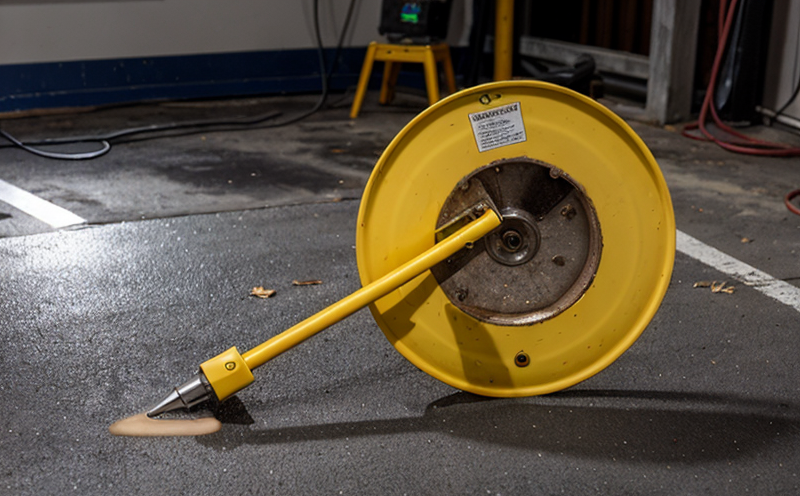ISO 16810 General Principles of Ultrasonic Testing
The ISO standard ISO 16810 provides a comprehensive framework for the general principles of ultrasonic testing (UT). This standard is widely used in various sectors including aerospace, automotive, and medical devices to ensure product quality and reliability. UT is non-destructive and relies on sound waves that propagate through materials to detect flaws such as cracks, voids, and other discontinuities.
Ultrasonic testing works by directing high-frequency sound waves into a specimen, typically using a probe that sends pulses of ultrasound into the material. If there are defects within the material, they reflect or absorb some of the sound energy, which can be detected by the probe. This reflection is then analyzed to determine if any flaws exist and their location.
The standard outlines key parameters such as frequency range, coupling medium, and test conditions that must be adhered to ensure accurate and reliable results. Frequency ranges vary depending on the material being tested; for instance, lower frequencies are often used in thicker materials like steel plates or castings whereas higher frequencies may be used for thinner components.
Preparation of specimens before testing is crucial according to ISO 16810. This includes cleaning surfaces, removing surface contamination, and ensuring that the test area has consistent acoustic impedance across its entire length. Specimen preparation directly affects the accuracy of UT results; improperly prepared samples can lead to erroneous readings or missed defects.
The standard also specifies acceptance criteria based on defect size, location, orientation relative to the primary loading direction of the part, and other factors relevant to the specific application area. Defects exceeding these limits would typically be considered unacceptable for use in critical applications.
UT systems used for compliance with ISO 16810 include both contact probes that come into direct physical contact with the surface being inspected as well as immersion techniques where transducers are placed under a layer of liquid. Both methods require careful calibration and maintenance to maintain precision over time.
In practice, companies often need to perform multiple types of inspections during their manufacturing processes including UT alongside other non-destructive evaluation (NDE) methods like radiography or magnetic particle inspection (MPI). By incorporating ISO 16810 into these broader programs, organizations can ensure consistent application across different facilities and personnel.
The benefits of adhering to this standard extend beyond just meeting regulatory requirements; it helps maintain high standards throughout the supply chain. When suppliers demonstrate their ability to comply with internationally recognized practices like those outlined in ISO 16810, buyers gain confidence knowing that quality controls are robust enough to handle even very demanding applications.
Applied Standards
| Standard | Description |
|---|---|
| ISO 16810:2017 | General principles for ultrasonic testing of materials and components. |
| ASTM E309-18 | American Society for Testing Materials standard providing guidance on the use of ultrasonic inspection in manufacturing. |
| EN 45562:2017 | European Norm specifying requirements for the qualification and certification of personnel involved in NDE procedures including UT. |
Quality and Reliability Assurance
The implementation of ISO 16810 ensures consistent quality assurance practices across various industries by providing a standardized approach to ultrasonic testing. This consistency is vital given the complex nature of many modern manufacturing processes which frequently involve multiple stages where different types of inspections might be performed.
Adhering strictly to the parameters and acceptance criteria specified in ISO 16810 helps manufacturers identify potential issues early on, thereby preventing costly rework or scrapping defective products later down the line. For example, in aerospace manufacturing where even small imperfections could lead to catastrophic failures, such a rigorous quality control process is essential.
From an operational perspective, maintaining compliance with ISO 16810 also streamlines communication between different departments within companies involved in product development and production. It establishes clear expectations around what constitutes acceptable levels of flaw detection during UT procedures, which can help avoid misunderstandings or disputes over test results.
Competitive Advantage and Market Impact
- Maintains industry-leading quality standards through adherence to internationally recognized practices.
- Enhances reputation among customers who value reliability and precision in manufacturing processes.
- Promotes innovation by allowing companies to focus on advancing technologies rather than constantly adapting to changing regulatory requirements.
- Fosters collaboration between suppliers and buyers, strengthening relationships based on mutual trust and shared commitment to excellence.
By leveraging ISO 16810 in their operations, businesses can gain a competitive edge by demonstrating superior product quality. This is particularly important when competing globally against firms from countries where similar standards are either voluntary or less strictly enforced.
The standard also plays a role in shaping market trends towards higher expectations for quality and safety across all sectors. As more industries adopt these principles, it becomes increasingly difficult for non-compliant competitors to maintain their presence in markets demanding strict adherence to international best practices.





